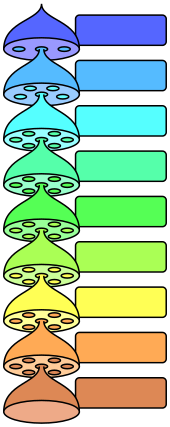|
Kingdom Bacteria
Subkingdom Negibacteria
Infrakingdom Lipobacteria
Superphylum Eobacteria
Phylum Heliobacteria
Phylum Hadobacteria
Subphylum Chlorobacteria
Subphylum Deinobacteria
Superphylum Endoflagellata
Phylum Spirochaetae
Subphylum Euspirochaetae
Subphylum Leptospirae
Infrakingdom Glycobacteria
Superphylum Pimelobacteria
Phylum Sphingobacteria
Subphylum Chlorobibacteria
Subphylum Flavobacteria
Phylum Eurybacteria
Subphylum Sclenobacteria
Subphylum Fusobacteria
Subphylum Fibrobacteria
Phylum Cyanobacteria
Subphylum Gloeobacteria
Subphylum Phycobacteria
Phylum Proteobacteria
Subphylum Rhodobacteria
Infraphylum Alphabacteria
Infraphylum Chromatibacteria
Subphylum Thiobacteria
Superphylum Planctobacteria
Phylum Planctobacteria
Subkingdom Unibacteria
Infrakingdom Posibacteria
Phylum Posibacteria
Subphylum Teichobacteria
Infraphylum Endobacteria
Infraphylum Actinobacteria
Subphylum Togobacteria
Infrakingdom Archaebacteria
Phylum Mendosicutes
Subphylum Euryarcheota
Infraphylum Halomebacteria
Infraphylum Eurytherma
Subphylum Sulfobacteria
|
Kingdom Protozoa
Subkingdom Archezoa
Phylum Metamonada
Subphylum Eopharyngia
Subphylum Axostylaria
Phylum Trichozoa
Subphylum Anaeromonada
Subphylum Parabasala
Subkingdom Neozoa
Infrakingdom Sarcomastigota
Phylum Neomonada
Subphylum Apusozoa
Subphylum Isomita
Subphylum Choanozoa
Phylum Cercozoa
Subphylum Phytomyxa
Subphylum Reticulofilosa
Subphylum Monadofilosa
Phylum Foraminifera
Phylum Amoebozoa
Subphylum Lobosa
Subphylum Conosa
Infraphylum Archamoebae
Infraphylum Mycetozoa
Superclass Eumyxa
Superclass Dictyostelia
Infrakingdom Discicristata
Phylum Percolozoa
Subphylum Tetramitia
Subphylum Pseudociliata
Phylum Euglenozoa
Subphylum Plicostoma
Subphylum Saccostoma
Infrakingdom Alveolata
Superphylum Miozoa
Phylum Dinozoa
Subphylum Protalveolata
Subphylum Dinoflagellata
Phylum Sporozoa
Subphylum Gregarinae
Subphylum Coccidiomorpha
Subphylum Manubrispora
Superphylum Heterokaryota
Phylum Ciliophora
Subphylum Tubulicorticata
Subphylum Epiplasmata
Subphylum Filocorticata
Infrakingdom Actinopoda
Phylum Heliozoa
Phylum Radiozoa
Subphylum Spasmaria
Subphylum Radiolaria
|
Kingdom Fungi
Subkingdom Eomycota
Phylum Archemycota
Subphylum Dictyomycotina
Class Chytridiomycetes
Subclass Rumpomycetidae
Subclass Spizomycetidae
Class Enteromycetes
Subphylum Melanomycotina
Infraphylum Allomycotina
Class Allomycetes
Infraphylum Zygomycotina
Superclass Eozygomycetia
Class Bolomycetes
Class Glomomycetes
Superclass Neozygomycetia
Class Zygomycetes
Subclass Mucoromycetidae
Subclass Meromycetidae
Class Zoomycetes
Subclass Entomycetidae
Subclass Pedomycetidae
Superorder Trichomycetalia
Superorder Pyxomycetalia
Phylum Microsporidia
Class Minisporea
Class Microsporea
Subclass Pleistophorea
Subclas Disporea
Subkingdom Neomycota
Phylum Ascomycota
Subphylum Hemiascomycotina
Class Taphrinomycetes
Class Geomycetes
Class Endomycetes
Subclass Dipomycetidae
Subclass Saccharomycetidae
Subphylum Euascomycotina
Class Discomycetes
Subclass Calycomycetidae
Subclass Lecomycetidae
Subclass Pezomycetidae
Class Pyrenomycetes
Subclass Verrucomycetidae
Subclass Ostiomycetidae
Class Loculomycetes
Subclass Dendromycetidae
Subclass Loculoascomycetidae
Class Plectomycetes
Phylum Basidiomycota
Subphylum Septomycotina
Class Septomycetes
Subclass Sporidiomycetidae
Subclass Uredomycetidae
Subphylum Orthomycotina
Superclass Hemibasidiomycetia
Class Ustomycetes
Superclass Hymenomycetia
Class Gelimycetes
Subclass Tremellomycetidae
Subclass Dacrymycetidae
Subclass Auromycetidae
Class Homobasidiomycetes
Subclass Clavomycetidae
Subclass Pileomycetidae
|
Kingdom Animalia
Subkingdom Radiata
Infrakingdom Spongiaria
Phylum Porifera
Subphylum Hyalospongiae
Subphylum Calcispongiae
Subphylum Archaeocyatha †
Infrakingdom Coelenterata
Phylum Cnidaria
Subphylum Anthozoa
Subphylum Medusozoa
Infrakingdom Placozoa
Phylum Placozoa
Subkingdom Myxozoa
Phylum Myxosporidia
Subkingdom Bilateria
Branch Protostomia
Infrakingdom Lophozoa
Superphylum Polyzoa
Phylum Bryozoa
Subphylum Gymnolaemata
Subphylum Lophopoda
Phylum Kamptozoa
Subphylum Entoprocta
Subphylum Cycliophora
Superphylum Conchozoa
Phylum Mollusca
Subphylum Bivalvia
Subphylum Glossophora
Infraphylum Univalvia
Infraphylum Spiculata
Infraphylum Cephalopoda
Phylum Brachiozoa
Subphylum Brachiopoda
Subphylum Phoronida
Superphylum Sipuncula
Phylum Sipuncula
Superphylum Vermizoa
Phylum Annelida
Subphylum Polychaeta
Infraphylum Operculata
Infraphylum Pharyngata
Subphylum Clitellata
Subphylum Echiura
Subphylum Pogonophora
Phylum Nemertina
Infrakingdom Chaetognathi
Phylum Chaetognatha
Infrakingdom Ecdysozoa
Superphylum Haemopoda
Phylum Arthropoda
Subphylum Cheliceromorpha
Infraphylum Pycnogonida
Infraphylum Chelicerata
Subphylum Trilobitomorpha †
Subphylum Mandibulata
Infraphylum Crustacea
Infraphylum Myriapoda
Infraphylum Insecta
Phylum Lobopoda
Subphylum Onychophora
Subphylum Tardigrada
Superphylum Nemathelminthes
Phylum Nemathelminthes
Subphylum Scalidorhyncha
Infraphylum Priapozoa
Infraphylum Kinorhyncha
Subphylum Nematoida
Infraphylum Nematoda
Infraphylum Nematomorpha
Infrakingdom Platyzoa
Phylum Acanthognatha
Subphylum Trochata
Infraphylum Rotifera
Infraphylum Acanthocephala
Subphylum Monokonta
Phylum Platyhelminthes
Subphylum Turbellaria
Infraphylum Mucorhabda
Infraphylum Rhabditophora
Subphylum Neodermata
Infraphylum Trematoda
Infraphylum Cercomeromorpha
Branch Deuterostomia
Infrakingdom Coelomopora
Phylum Hemichordata
Subphylum Pterobranchia
Subphylum Enteropneusta
Phylum Echinodermata
Subphylum Homalozoa
Subphylum Pelmatozoa
Infraphylum Blastozoa
Infraphylum Crinozoa
Subphylum Eleutherozoa
Infraphylum Asterozoa
Infraphylum Echinozoa
Infrakingdom Chordonia
Phylum Urochorda
Subphylum Tunicata
Infraphylum Ascidiae
Infraphylum Thaliae
Subphylum Appendicularia
Phylum Chordata
Subphylum Acraniata
Infraphylum Cephalochordata
Infraphylum Conodonta †
Subphylum Vertebrata
Infraphylum Agnatha
Infraphylum Gnathostomata
Subkingdom Mesozoa
Phylum Mesozoa
|
Kingdom Plantae
Subkingdom Biliphyta
Infrakingdom Glaucophyta
Phylum Glaucophyta
Infrakingdom Rhodophyta
Phylum Rhodophyta
Subphylum Rhodellophytina
Subphylum Macrorhodophytina
Subkingdom Viridiplantae
Infrakingdom Chlorophyta
Phylum Chlorophyta
Subphylum Chlorophytina
Infraphylum Prasinophytae
Infraphylum Tetraphytae
Subphylum Phragmophytina
Infraphylum Charophytae
Infraphylum Rudophytae
Infrakingdom Cormophyta
Phylum Bryophyta
Subphylum Hepaticae
Subphylum Anthocerotae
Subphylum Musci
Infraphylum Sphagneae
Infraphylum Bryatae
Phylum Tracheophyta
Subphylum Pteridophytina
Infraphylum Psilophytae
Infraphylum Lycophytae
Infraphylum Sphenophytae
Infraphylum Filices
Subphylum Spermatophytina
Infraphylum Gymnospermae
Infraphylum Angiospermae
|
Kingdom Chromista
Subkingdom Cryptista
Phylum Cryptophyta
Subkingdom Chromobiota
Infrakingdom Heterokonta
Superphylum Sagenista
Phylum Sagenista
Subphylum Bicoecia
Subphylum Labyrinthista
Phylum Ochrophyta
Subphylum Phaeista
Infraphylum Hypogyrista
Infraphylum Chrysista
Subphylum Diatomeae
Phylum Bigyra
Subphylum Bigyromonada
Subphylum Pseudofungi
Subphylum Opalinata
Infrakingdom Haptophyta
Phylum Haptophyta
|
